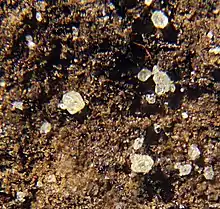| Rosickyite | |
|---|---|
 Sharp yellow crystals of rosickyite on matrix from an unspecified off shore drill hole in the Pacific Ocean near California (Ventura County, California, United States of America). | |
| General | |
| Category | Native element mineral |
| Formula (repeating unit) | S |
| IMA symbol | Rký[1] |
| Strunz classification | 1.CC.05 |
| Crystal system | Monoclinic |
| Crystal class | Prismatic (2/m) (same H-M symbol) |
| Space group | P2/c |
| Unit cell | a = 8.455(3) Å, b = 13.052(2) Å c = 9.267(3) Å; β = 124.89(3)°; Z = 4 |
| Identification | |
| Color | Colorless to pale yellow, green tinge |
| Crystal habit | Equidimensional to thin tabular crystals, efflorescences |
| Twinning | On {101}, with twin lamellae parallel to [010] |
| Cleavage | None |
| Mohs scale hardness | 2 - 3 |
| Luster | Adamantine |
| Diaphaneity | Transparent to translucent |
| Specific gravity | 2.07 |
| Optical properties | Biaxial (-) |
| References | [2][3][4] |
Rosickyite is a rare native element mineral that is a polymorph of sulfur. It crystallizes in the monoclinic crystal system and is a high temperature, high density polymorph. It occurs as soft, colorless to pale yellow crystals and efflorescences.[2][3]
It was first described in 1930 for an occurrence in Havirna, near Letovice, Moravia, Czech Republic. It was named for Vojtĕch Rosický (1880–1942), of Masaryk University, Brno.[2][3]
Rosickyite occurs as in Death Valley within an evaporite layer produced by a microbial community. The otherwise unstable polymorph was produced and stabilized within a cyanobacteria dominated layer.[5]
References
- ↑ Warr, L.N. (2021). "IMA–CNMNC approved mineral symbols". Mineralogical Magazine. 85 (3): 291–320. Bibcode:2021MinM...85..291W. doi:10.1180/mgm.2021.43. S2CID 235729616.
- 1 2 3 Handbook of Mineralogy
- 1 2 3 Rosickyite on Mindat.org
- ↑ Rosickyite on Webmineral.com
- ↑ Susanne Douglas and Heixong Yang, Mineral biosignatures in evaporites: Presence of rosickyite in an endoevaporitic microbial community from Death Valley, California, Geology, Dec. 2002, v 30, pp1075-1078
This article is issued from Wikipedia. The text is licensed under Creative Commons - Attribution - Sharealike. Additional terms may apply for the media files.